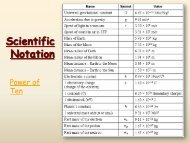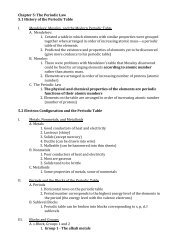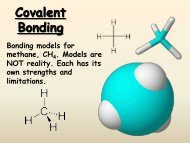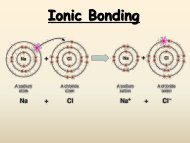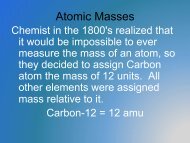Unit 4: Chemical Bonding and Molecular Structure Chapter 6 Notes ...
Unit 4: Chemical Bonding and Molecular Structure Chapter 6 Notes ...
Unit 4: Chemical Bonding and Molecular Structure Chapter 6 Notes ...
Create successful ePaper yourself
Turn your PDF publications into a flip-book with our unique Google optimized e-Paper software.
6.4 Metallic <strong>Bonding</strong> <br />
I. The Metallic Bond Model <br />
A. Metallic <strong>Bonding</strong> <br />
1. The chemical bonding that results from the attraction between metal atoms <br />
<strong>and</strong> the surrounding sea of electrons <br />
B. Electron Delocalization in Metals <br />
1. Vacant p <strong>and</strong> d orbitals in metal's outer energy levels overlap, <strong>and</strong> allow <br />
outer electrons to move freely throughout the metal <br />
2. Valence electrons do not belong to any one atom <br />
II. Metallic Properties <br />
A. Metals are good conductors of heat <strong>and</strong> light <br />
B. Metals are shiny <br />
1. Narrow range of energy differences between orbitals allows electrons to be <br />
easily excited, <strong>and</strong> emit light upon returning to a lower energy level <br />
C. Metals are Malleable <br />
1. Can be hammered into thin sheets <br />
D. Metals are ductile <br />
1. Ability to be drawn into wire <br />
a. Metallic bonding is the same in all directions, so metals tend not to be <br />
brittle <br />
E. Metals atoms organized in compact, orderly crystalline patterns <br />
F. Different metallic elements (<strong>and</strong> carbon) can be mixed to form alloys <br />
1. Sterling silver <br />
a. Ag = 92.5%, Cu = 7.5% <br />
2. Brass <br />
a. Cu = 60%, Zn = 40% <br />
6.5 <strong>Molecular</strong> Geometry <br />
A. VSEPR theory <br />
1. valence-‐shell, electron-‐pair repulsion <br />
2. states that repulsion between the sets of valence-‐level electrons surrounding <br />
an atom causes these sets to be oriented as far apart as possible <br />
3. shared pairs of electrons will be as far apart from each other as possible <br />
B. Unshared Electron Pairs <br />
1. Lone pairs (unshared electron pairs) occupies space around the atom just as <br />
bonding pairs do. <br />
2. Lone pairs have a relatively greater effect on geometry than shared pairs <br />
(Have greater repusive forces & tend to compress the angles between <br />
bonding pairs) <br />
C. Double <strong>and</strong> triple bonds are treated in the same way as single bonds <br />
D. Polyatomic ions are treated similarly to molecules.






